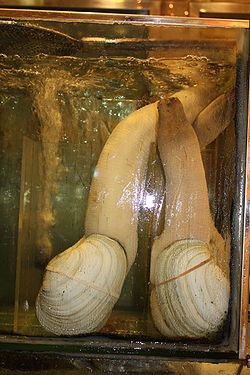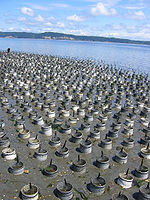Geoduck
| Geoduck |
|---|

|
| Scientific Classification |
|
| Binomial Name |
|
Panopea generosa |
| Geoducks at Market |
Geoducks are a species of clam known by the scientific name Panopea generosa. The geoduck gets its name from a form of a Native American word meaning “dig deep”. The Geoduck lives in the West Coast of North America, mostly in Washington and British Columbia. The clams are best known for their large siphons that can be over three feet in length. As adults they have very few predators other than humans[2]. The average life expectancy of a geoduck is 146 years. This makes them one of the longest living members of the animal kingdom[3].
Body Design
A geoduck is a large species of bivalve clam. It has a rectangular shell that can be up to nine or ten inches long and five inches high. Each of the valves are equal in size and have irregularly shaped lines that indicate growth. The geoduck’s ligament hinge connects and holds the two valves together. The shell is covered by a thin covering called the periostracum. The periostracum protects the valve's middle layer from scratches and abrasions[4]. The geoduck is best known for its large siphon. The siphon itself may grow to over three feet in length. Inside the siphon there are two tubes: the inhalant and the exhalent tubes. The geoduck takes in water with its inhalant tube and expels waste through it exhalent tube. Like all clams the geoduck has a foot. It uses its foot to burrow into the ground where it then lives for the rest of its life[4].
Life Cycle
Geoducks reproduce sexually by spawning. Spawning is the process of aquatic animals releasing the eggs and sperm into the water in order to reproduce. The geoducks usually spawn from the late winter to early summer months. The greatest amount of activity occurs during the months of May and June. During this time the male spawns millions of sperm into the water. The females then spawn their eggs and that can be as many as five million at a time[4]. The sperm and egg unite to form ciliated larvae called trocophores. These trocophores are very small and hard to see. The larva then changes forming an organ used for swimming called a velum. The shell begins to form and then soon after it loses its velum, spines grow on the outer edges of the shell and it settles on the seafloor. Then as the geoduck matures it burrows down in the sediment and reaches a maximum depth of about three feet[4].
Ecology
The geoduck clam can be found along the West Coast of North America, in locations ranging from Baja, California all the way to Alaska. It lives in lower intertidal and subtidal zones of bays, sloughs, and estuaries. Geoducks bury themselves below the sand and extend their siphon out to filter feed. They will burrow in any substrate, from soft mud to pea gravel. The geoduck is a filter feeder. This means it will eat any small organisms that it filters through its siphon. The major food source of Panopea generosa is phytoplankton. The predators of the geoduck includes: humans, crabs, sea stars, sea otters, and snails. Even with all of these threats some geoducks can live to be over a hundred years old.[4]
Washington’s Puget Sound has the highest geoduck density in the continuous United States. Around 109 million adult geoducks are located in the Sound. They are the largest number of marine animals in the Sound. They can be found living in the Sound’s bays and estuaries and are most populous in the southern part. They are usually found at depths between ten and eighty feet but have been recorded as deep as 360 feet.[5]
The Geoduck Industry
The world’s first geoduck farm was started in 1970, but due to the clam’s texture its demand was low. As of today they can be sold for up to $168 a pound in Asia. Its large siphon is prized for its flavor and texture.[6] In Washington, the fisheries are closely regulated by the Department of Natural Resources. The Department of Natural Resources and its staff continually monitor harvests and revenues, while the Washington State Department of Health monitors the geoduck’s environmental impact. The Washington State Department of Health tests water and flesh to confirm that the geoducks are not filtering and absorbing pollutants. Advances in the testing system have allowed for a more consistent delivery of clams. These new methods test the geoduck before the harvest versus after the harvest. This advancement helped 90% of clams sold to reach market alive in 2007.[6]
Video
Washington State DNRs Aquatic Resources Division Assistant Manager, Blain Reeves, describes the basics of Washington's wild geoduck harvest, and the efforts put forth to keep it sustainable.
References
- ↑ Panopea-generosa "ITIS-Report". Web. December 2, 2012(Date-of-access).
- ↑ EOL-Geoduck “EOL”. Web. December 11, 2012(Date-of-access).
- ↑ Dave,Cap’tMAKING CLAMS PAY The Big Bad Geoduck “Puget-Sound-Magazine.com’’. Web. December 11, 2012(Date-of-access).
- ↑ 4.0 4.1 4.2 4.3 4.4 Ever-green marine-life-1011. Web. March 7, 2011(Date-of-publication). Cite error: Invalid
<ref>tag; name "mlife" defined multiple times with different content - ↑ Geoduck Clam "Puget-Sound-Shorelines". Web. December 13, 2012(Date-of-access).
- ↑ 6.0 6.1 The Geoduck industry Steering-The-Industry-From-Fishing.... Web. December 4, 2012(Date-of-access)




